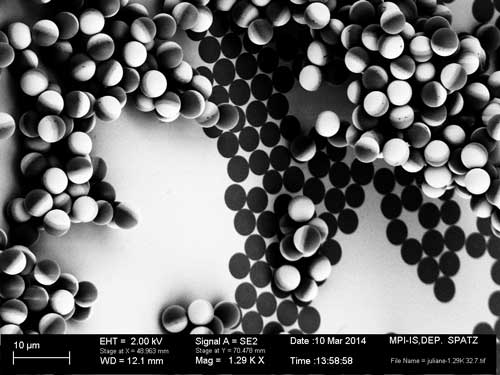| Posted: Oct 05, 2016 |
Researching a new kind of energy input for micromotors
(Nanowerk News) Dr. Juliane Simmchen is going to explore new paths in chemistry. Being awarded a “Freigeist” Fellowship by the Volkswagen Foundation over 844.000 Euro for the next five years, Dr. Simmchen will establish her own junior research team at the Chair of Physical Chemistry (Prof. Alexander Eychmüller) at TU Dresden.
|
|
The team will be researching a new kind of energy input for micromotors – fascinating novel devices bearing great potential for future technology.
|
 |
| Electron microscope image of nanoscale Janus particles, which the Freigeist-group is going to test regarding their capacity as photocatalytic nanomotors. (Image: Juliane Simmchen)
|
|
A ‘Freigeist’ fellow: for the Volkswagen Foundation this means a young researcher with a strong personality, a creative mind, an ability to identify and use freedom, dedicated to overcoming resistance. Dr. Juliane Simmchen of TU Dresden is one of these extraordinary researchers who wants to overcome existing disciplinary boundaries to gain innovative insights.
|
|
During her doctoral thesis in Barcelona/Madrid and as a postdoc at the MPI in Stuttgart, she had been researching catalytic micromotors – a fascinating new field in the movement at the microscale connecting several disciplines of modern science. Micro- and nanomotors are novel devices which can transform energy into movement. Unlike large scale engines dominated by inertia, however, the movement of objects at the microscale requires a constant energy input.
|
|
Collaborating with the group of Prof. Eychmüller, Dr. Simmchen now aims at setting a new course in her work. With photocatalytic reactions on the surface of nanoparticles, the Freigeist group wants to research sunlight driven nanomotors. In combining the two innovative fields of photocatalysts and nanomotors, Dr. Simmchen wants to open new horizons for the use of nanomotors driven by renewable energy in several environmental and analytical applications.
|
|
So far, micromotors have been chemically or magnetically driven, often under the use of toxic chemicals. Photocatalytic micromotors, however, could be used for environmental remediation. Not only would using a renewable energy source (namely sunlight) drastically improve the general impact for the environment, sunlight driven micromotors would also increase the mixing and catalytic degradation of organic pollutants. Another potential application lies in novel sensors based on the observation of motion of fluorescently labelled molecules or biological markers. This might pave the way for high sensitivity detection and facilitate the mostly complex sample preparation though self-propelled isolation of the species in focus.
|

